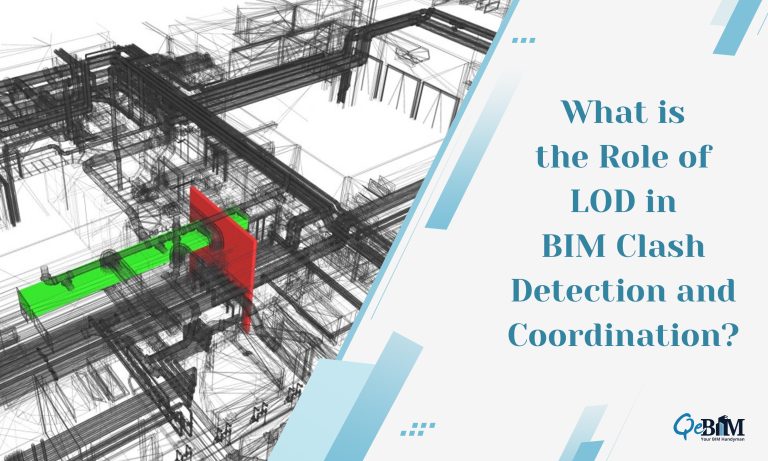What is the Role of LOD in BIM Clash Detection and Coordination?

Considering the scenario of architecture, construction and design, BIM stands out as a revolutionary and the most innovative approach that promises efficiency, efficacy, accuracy, and collaboration. At the centre of BIM lies the concept of LOD or Level of Development. LOD is indeed a critical factor that significantly influences the clash detection as well as coordination throughout the project lifecycle. Let us understand it in detail in the given article.
Understanding LOD in BIM
LOD serves as a roadmap for the level of detail and development of elements within a BIM model at different stages of any of the construction project. It ranges from LOD 100, representing conceptual models with minimal detail, to LOD 500, signifying the highly detailed and elaborated models with as-built conditions. Each LOD level defines the extent of information available and associated for various elements like geometry, materials, attributes and so on.
Clash Detection: Unveiling Interferences
Clash detection is a crucial process in BIM that identifies any sort of conflicts or interferences among different building elements. These clashes could be caused from any spatial discrepancies, incompatible systems, or design inconsistencies. LOD, however plays a crucial role in achieving the effectiveness of clash detection by determining the granularity as well as accuracy of model elements.
At lower LOD levels, such as LOD 100 or LOD 200, where the models are primarily conceptual or schematic, clash detection may yield fewer results due to the lack of detailed geometry and information. But as the project progresses and LOD increases, clash detection becomes a more robust task enabling stakeholders to identify and resolve clashes with higher precision.
Coordination: Enhancing Collaboration
BIM Coordination Services revolves around aligning of various disciplines, such as architecture, structural, and MEP systems, to ensure a seamless integration and functionality of any building systems. LOD to a greater extent influences this coordination by dictating the level of information available for different disciplines and facilitating interdisciplinary collaboration.
Considering the early stages of a construction project, coordination efforts might focus on a conceptual alignment as well as basic spatial relationships as compared to the lower LOD levels. As the project advances and LOD escalates, coordination becomes a more detailed and comprehensive, allowing the stakeholders to address the crucial design intricacies and system integrations effectively.
The Impact of LOD on Clash Detection and Coordination
- Early Detection of Issues: Higher LOD levels allow for quite an early identification of clashes as well as coordination issues thereby minimizing the costly rework and delays. With a detailed geometry and information, AEC professionals and stakeholders can foresee the potential conflicts well in advance and resolve them proactively during the design phase itself.
- Improved Collaboration: By providing a common platform with a detailed and accurate model, higher LOD levels promotes fluent collaboration among the project teams. Disciplines can share information, coordinate designs, and address conflicts more effectively, leading to a more smoother project execution.
- Precision in Decision-Making: As LOD level increases, the stakeholders can gain access to more precise data and insights, empowering informed decisions. Whether it be optimizing a building system or resolving clashes, higher LOD levels equip the teams with the necessary information to make any strategic choices that align directly with the project objectives.
- Efficiency in Construction: Any detailed models resulting from the higher LOD levels facilitate for a smoother construction process by reducing the ambiguity and uncertainty. Contractors can better understand the project requirements, anticipate challenges, as well as streamline construction workflows, ultimately enhancing the construction productivity and minimizing the reworks to a greater extent.
Best Practices for LOD Implementation
To maximize the benefits of LOD in clash detection and coordination, it is quite essential to adhere to the best practices throughout the project lifecycle:
- Clear LOD Specifications: Establish the clear guidelines and specifications for LOD requirements at each project stage to ensure the consistency as well as alignment among AEC professionals.
- Progressive Detailing: Adopt a progressive yet detailing approach by gradually increasing the LOD as the project advances from conceptualization to construction and towards as-built stages.
- Interdisciplinary Communication: Allow for a open communication and collaboration among the project teams to address the interdisciplinary coordination challenges effectively.
- Continuous Review and Refinement: Regularly review as well as refine the BIM models to incorporate all the design changes, address clashes, and ensure the apt alignment with the project goals.
Conclusion
When we talk about BIM, LOD serves as a cornerstone for clash detection and coordination, shaping the effectiveness and efficiency of any construction workflows. By understanding the impact of LOD on these processes and implementing the industry best practices, stakeholders can harness the full potential of BIM to deliver successful projects with minimal conflicts and maximum collaboration. As technology is advancing in the AEC industry, option for a trusted BIM Service Provider becomes increasingly imperative for driving innovation and excellence in the construction projects.